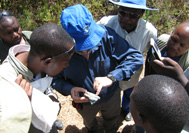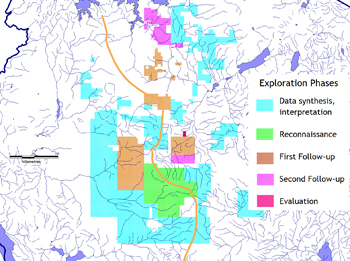Exploration StrategyMulti-mineral strategy focused on diamonds, gold, base metals and uraniumLeland pursues a multi-mineral strategy, focused on the discovery and development of primary diamond deposits in addition to gold, base metals and uranium. Success is being achieved in exploring a vast expanse of untested territory in central Tanzania by applying innovative thinking and modern techniques. At the heart of this success is a highly disciplined, phased, approach to exploring this major land position. Our objective is to rapidly assess our ground focusing our resources on prospective areas and relinquishing non prospective holdings. High resolution airborne geophysics is the perfect tool for this purpose. DiamondsThe central region of Tanzania is divided by a major north-south watershed. The development of streams and rivers to the east is markedly more pronounced than that to the west and, using digital elevation modelling, it can be readily established that the west is an area of flat terrain whereas the east is heavily dissected by watercourses. The sole method for kimberlite exploration in the 1950's was the collection of surface sediment samples to recover Kimberlite Indicator Minerals (KIM's). These would have been incorporated into the surface and stream sediments where kimberlites were exposed by erosion i.e. to the east of the watershed. Owing to the flat terrain west of the watershed, no or little erosion would have taken place; hence historic sediment sampling techniques would not have been effective in identifying kimberlites. Limited kimberlite exploration in the 1990's, centred on the sixty-year old diamond mine, Mwadui, utilising modern geophysical techniques and refined sampling methods, resulted in the discovery of approximately 100 more kimberlites. By inference (and applying increasingly more advanced techniques), other areas which are known to host kimberlites and, more significantly, areas which would have produced few sample results in the 1950's and 1960's (i.e. west of the watershed, an area licensed in its entirety by Leland) are considered to have the potential to contain not only new kimberlites but entirely new, undiscovered, kimberlite provinces. Gold, Base Metals and UraniumSurprisingly, much of Tanzania has seen little exploration for commodities other than diamonds, with the exception of the Lake Victoria Goldfield and areas around Mbeya to the south. The lack of rock outcrop in much of the central region has precluded all but very large-scale geological mapping. The general increase in knowledge of different styles of mineralisation since the 1950's allows for a much better interpretation of the results of geochemical sampling and from geological structure derived from modern geophysical sources. |
   |




